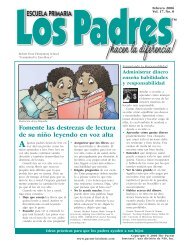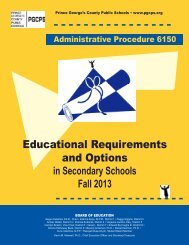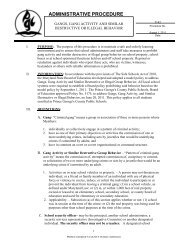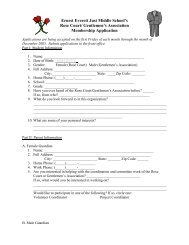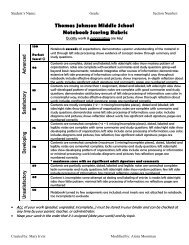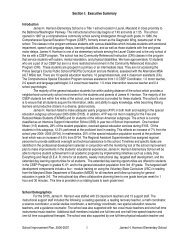Why Middle Schools Are Being Questioned
Why Middle Schools Are Being Questioned
Why Middle Schools Are Being Questioned
- No tags were found...
Create successful ePaper yourself
Turn your PDF publications into a flip-book with our unique Google optimized e-Paper software.
<strong>Why</strong> <strong>Middle</strong> <strong>Schools</strong> <strong>Are</strong> <strong>Being</strong> <strong>Questioned</strong>By DEBRA NUSSBAUMPublished: September 12, 2004T is the time of braces, changing bodies, shorts that look too baggy and backpacks thatlook too big. The sixth graders approach their building asking, "Where do we go?" whilemost seventh and eighth graders know how to exude an air of confidence.Welcome to middle school - grades six, seven and eight and ages 11 though 14. Someeducators say that putting such a volatile age group together in the same building issimply a "prescription for problems," while others see it as a unique time of life and onethat is essential so that these students, giddy in a period of rampant self-discovery, aregiven their own learning environment.In New Jersey, home to 335 middle schools, a debate over what to do with them seems tobe playing out largely along urban and suburban lines. As the doors opened last week formost of New Jersey's 1.4 million public school students, some of the state's urbandistricts - such as Newark, Paterson and Trenton - found themselves in the process ofclosing the book on middle schools altogether. In their place, those districts are choosingto place students in kindergarten through eighth grade in one building before sendingthem off to the harsh realities of high school.Nor are the urban schools in New Jersey alone in such thinking. Baltimore, Clevelandand Philadelphia are also converting their middle schools to long-term elementarybuildings that will go all the way through eighth grade.But most educators in suburban towns throughout the state - including such districts asPrinceton, Millburn and Cherry Hill - say they are comfortable with the middle schoolconcept, which they contend provides a smooth transition to high school."The middle school concept and program in Princeton is quite strong," said Dr. JeffGraber, assistant superintendent for curriculum and instruction in Princeton, where theJohn Witherspoon <strong>Middle</strong> School is undergoing an $18 million expansion and renovationthat will include more classrooms, science labs, a larger auditorium and an indoor pool.As Dr. Graber put it: "For us it works, but every district has a different set ofcircumstances."In New Jersey, realigning the school structure is easier than one would think, sincedistricts are free to create their own configurations. The state does not mandate theexistence of middle schools, or that certain ages be grouped together.The change from K-8 schools followed by four-year secondary schools emerged in thelate 1800's. But in the early 1900's, the concept of junior high school - including grades
seven and eight and some instances nine - was born. Then, in the early 1960's, middleschools for grades six, seven and eight gained in popularity. But once again, thependulum is swinging back."We looked at the data and K-8 schools were functioning at a much higher level ofachievement," said Marion Bolden, superintendent of schools in Newark. "A typicalmiddle school that is too large struggles. I absolutely think more and more urban districtswill look at K-8 and create more or keep what they have. It's such a great environment.It's more of a community school."Indeed, some of the largest urban districts in New Jersey - using money made available inthe last five years by the state's Abbott Facilities Program - plan to convert existingbuildings into kindergarten through eighth-grade schools and erect new ones to fit thatmold.Experience on the classroom level has been bolstered by several recent studies, includingthose conducted by the Rand Corporation, a research organization, and the PhiladelphiaEducation Fund, a nonprofit group that aids public schools, which said the K-8 modeldeserved consideration because in many cases students fared better than in middleschools.A 2002 study by the Philadelphia Education Fund, in conjunction with Johns HopkinsUniversity and the University of Pennsylvania, looked at 3,000 Philadelphia students in"high poverty" - in which at least 80 percent of them came from low-income families.The study found that typically - though not in all cases - a "high-poverty K-8 schooloutperforms the typical high-poverty middle school." And this year the Rand Corporationsuggested that middle schools in the United States needed improvement and questionedtheir wisdom at a time when students are going through such vast changes.Studies by prestigious research organizations and universities notwithstanding, an articlein the March issue of Education Week with the headline "Report Questions Wisdom ofSeparate <strong>Middle</strong> <strong>Schools</strong>" evoked such a reaction from administrators in Cherry Hill thatTammy Murphy, an assistant superintendent, along with three middle school principals,responded with a three-page defense of middle school.It is a position shared by Dr. Richard Brodow, superintendent of the Millburn Townshipschools.For his part, Dr. Brodow said he would not consider changing to a K-8 model because themiddle school "works well for us."But Dr. Brodow, who started in the New York City schools, said he understood that whatworks in one district might not be successful in another. And he said he did notnecessarily subscribe to the theory that one school for kindergarten through eighth gradewas a city versus suburbs issue.
'Depends on the District'"It depends on the district," he said. "Every situation is unique. There are no cookie-cutteranswers, whether it's urban or suburban. There's no magic bullet."That said, the issue does seem to cut across those lines."We made our decision based on research and on the unique situation of Trenton," saidDr. James Lytle, the superintendent in Trenton, who was an administrator in Philadelphiapublic schools until 1998.The Trenton school district, which has 14,000 students, will not build any more middleschools and is in the process of converting some schools to kindergarten through theeighth grade and building new ones specifically for that configuration.Referring to the Philadelphia Education Fund study, Dr. Lytle said, "On almost anycriteria, kids in K-8 schools in the upper grades did better than those in middle schools,and Philadelphia makes a perfect test in terms of the debate."The question is why educators feel that middle school is an idea whose time has passed.One reason, cited by many administrators, is the idea that students do not always do wellwith change and by keeping them in the same building they will not have to cope with anew environment and all of the new faces in the faculty and staff; a K-8 school, on theother hand, provides the same neighborhood, building and staff for parents and studentsalike.In other words, educators in the state's more troubled urban areas view the K-8 formulaas a way to keep a lid on such problems as truancy and a high dropout rate, low academicperformance, violence, and substance abuse."It eliminates one transition," Dr. Lytle said. "The fifth- to sixth-grade transition is verydifficult. It's as if the kids lost a year. The K-8 school is more personal. There's acommunity feeling and a connection. Older kids mentor younger kids and become schoolleaders."Valerie Butler, the principal of Joyce Kilmer School in Trenton, which has 400uniformed students, including 150 in grades six through eight, says she prefers theconfiguration of her building for nurturing the children and upholding the standards andrules. Ms. Butler, who considers herself a "strict disciplinarian," said she encouragesclose contact between staff and parents, and likes the environment where teachers knowstudents who they have seen in the hallways for many years."If you see Johnny messing up in the hall, you can say something because you knowhim," she said. "Another thing that is good is the siblings. We have a lot of families withseveral children in our building. The parents and kids feel safer here."
Moreover, Ms. Butler pointed out that scores on the Grade Eight ProficiencyAssessments, given to every eighth grader by the state, have consistently improved underthe K-8 configuration."In our situation," she said, "it works. I think it's a case-by-case basis."But in reality, it is more than a case-by-case basis; it is a city-by-city basis.In Newark, Ms. Bolden, who has been superintendent for five years, says the K-8 modelworks best there also. The district of 44,000 students has about 60 elementary schools,with more than half of those schools housing K-8 programs. And she said that"depending on their success," only K-8 schools will be constructed in the future and otherschools could be converted to fit that model.To Ms. Bolden, a separate middle school can "look like a mini-high school."'More Nurturing Environment'"My kids need a more nurturing environment," she said.But even Newark will not completely eliminate middle schools. Ms. Bolden said theGladys Hillman Jones <strong>Middle</strong> School, with only 400 students in the seventh and eighthgrades, is "one stellar middle school with a strong principal and staff," so there is no needto change. She also said that the Luis Munoz Marn <strong>Middle</strong> School, with 1,100 students ingrades five through eight, performed well and would not be closed.The fact is, most urban districts using K-8 schools do change the format for students insixth, seventh and eighth grades. For instance, the children do not remain with the sameteacher all day, but change classes for different subject areas or have a team of teachersrather than just one teacher for each grade.When it comes to K-8 schools, the list of cities in New Jersey that is turning to this modelgoes on and on. In Paterson, the long-range plan calls for that format to replace all of themiddle schools and the construction of 10 K-8 schools, according to Mike Azzara,assistant superintendent for operations in the 27,000-student district.For now, Paterson uses a model in which the elementary schools include grades K-4 andthe middle school is composed of the fifth, sixth, seventh and eighth grades. But when thenew schools are built, the only middle schools to remain will be academies to whichstudents will have to apply to for admission.From Mr. Azzara's standpoint, the middle school years are "a difficult time to feelsecure," and so the K-8 model provides a more comforting environment."They are maturing and changing," he said. "They are difficult years emotionally forchildren, and one building for them is a prescription for problems."
Camden has taken a more mixed approach to the question of middle school. The districthas a combination of configurations, including some schools that include middle and K-8schools.Interestingly, neighborhoods with high truancy and dropout rates have turned to K-8schools during the last 10 years, said Bart Leff, a spokesman for the district, and "weseem to have made a dent in those areas."Only a stone's throw away, a different picture emerges. It is the second day of school inCherry Hill and the principal, Ed Canzanese, is standing outside the Rosa International<strong>Middle</strong> School with a walkie-talkie in his hand as the buses roll in. Weighted down withbags of school supplies among the 800 students are 250 sixth graders, some of whomlook a little bewildered and wear a look that says, "I'm not lost, but where do I go?"Taking in the scene, Mr. Canzanese observed: "They are not adults and not little kids.They need to forge their own identity. The quirkiness of this age group can be celebrated.They have raging intellects. The curiosity piece is at such an extreme. We can addresstheir needs consistently here."To this principal and like-minded school administrators, middle school allows teachers tocreate themes and activities directed at the 11-to-14 age group, trying to instillindependence while still providing support.At Rosa International, students sit at tables rather than desks, and there are extracurricularsports and clubs. Posters on the wall announce a sixth-grade canteen andseventh- and eighth-grade dances.Children also receive assurances that they can survive in a building with older students."Kids need to know that they can't be stuffed in a locker," Mr. Canzanese said. "Theywon't fit."But Ella Rideau, assistant principal of South Orange <strong>Middle</strong> School, sees both sides ofthe issue."It's not the same for every district, and there are advantages and disadvantages in bothmodels," said Ms. Rideau, who taught in a K-8 school in Phoenix.The way she sees it, while the K-8 schools allow a student to remain in the samenurturing environment for many years, they do not give a struggling student a chance fornew start. Moreover, K-8 schools cannot gear everything to the time of life when youthsare going through physical and emotional changes. "You can help them through thattransition," she said.'The Kids Can't Wait'
As Judy Levy, a spokeswoman for the South Orange- Maplewood School District put it:"Any time there's a change, everybody shudders. Parents look at middle school as thosebig schools. It's more fear for parents than the kids. The kids can't wait. They don't wantto be a little kid anymore. They are ready."For now, many educators say that not enough research has been done to know if onemodel works better than the other.Kathy Christie, a former middle school teacher and vice president of the EducationCommission of the States in Denver, a research organization, said there is "a growingpressure on districts to swap back to the K-8" schools. But while Ms. Christieacknowledges that middle schools have their problems, she does not advocate the end forthese institutions."The middle school concept is based on a good theory," she said.In an article that appeared in The Denver Post opinion page, Ms. Christie wrote that theidea of middle school "was to create a smaller, more personalized and less rigid learningenvironment than junior high school typically offered. The middle school philosophypromotes active, project-based learning and encourages exploration of issues andinterests across disciplinary areas."While she said that some middle schools were clearly struggling, she was not ready toabandon them."The fact is that there were good reasons behind the move to middle schools," she wrote."Simply reverting to earlier models need not be the only solution to frustration with thislevel of education."



